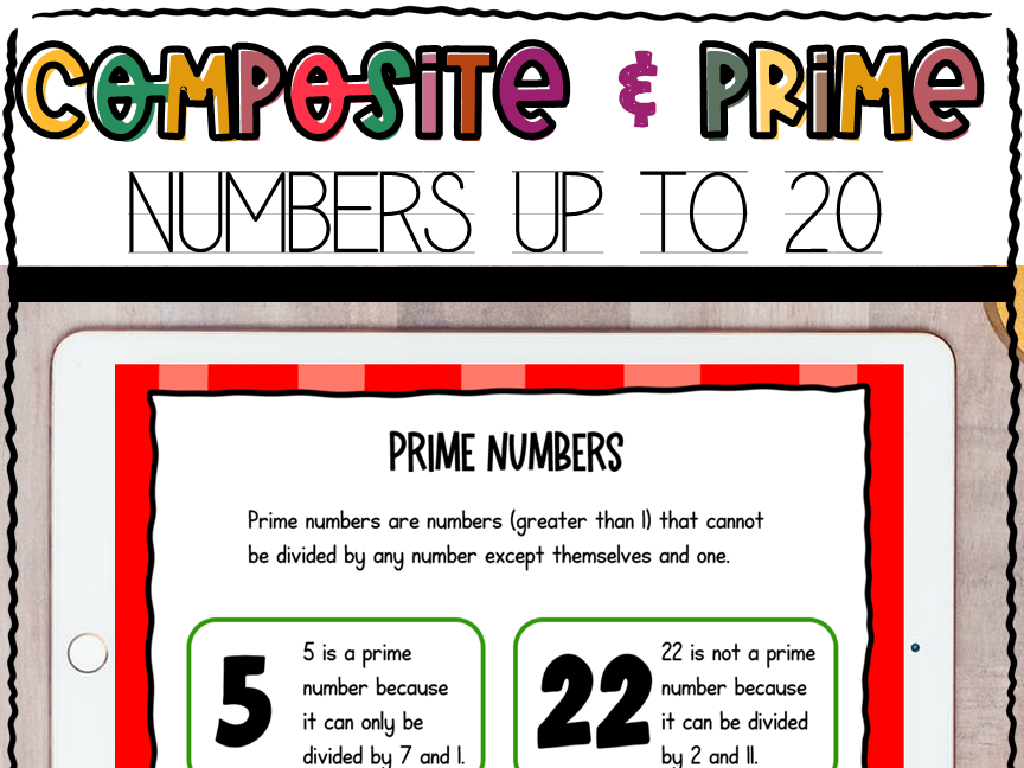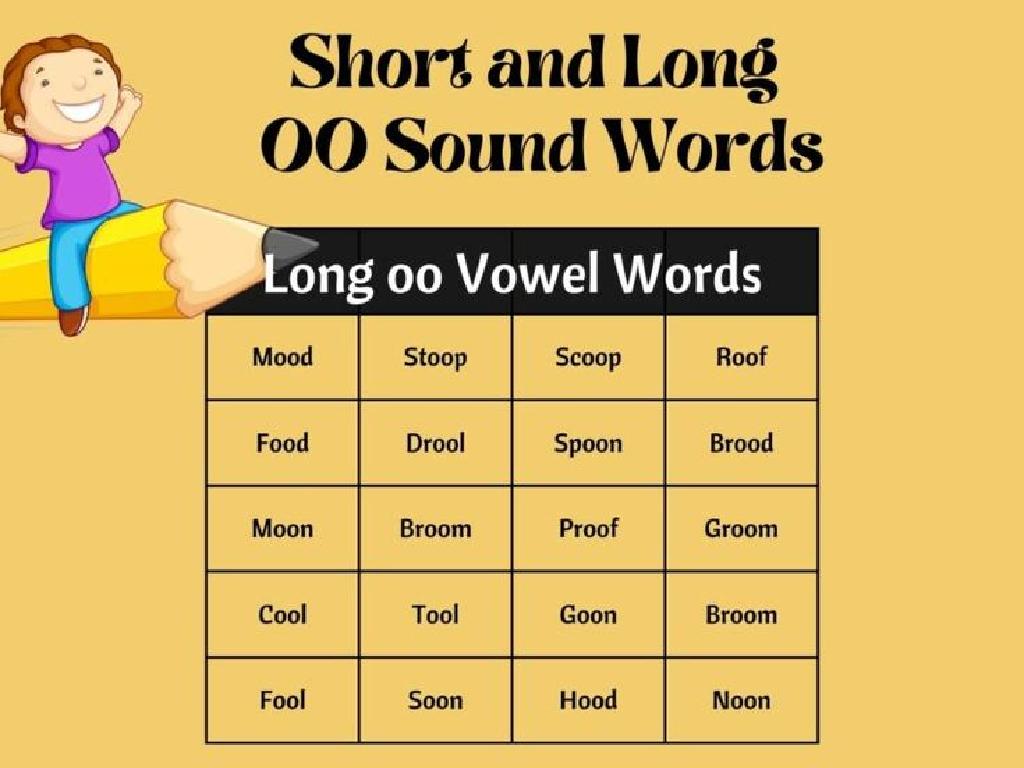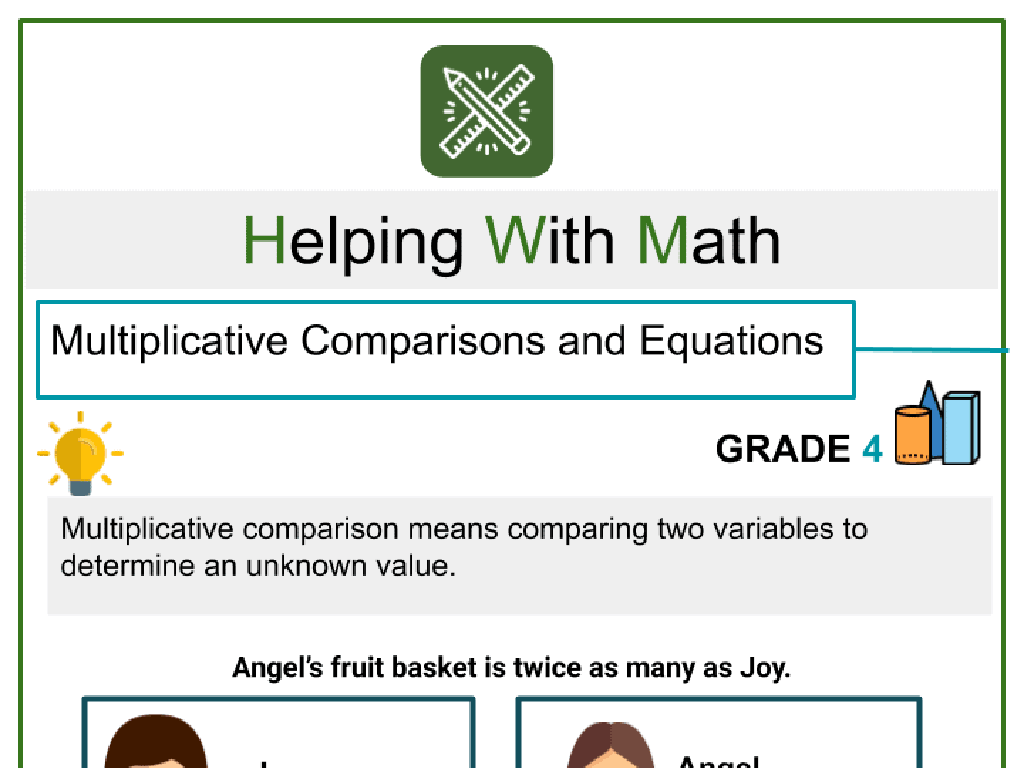Add Mixed Numbers With Unlike Denominators
Subject: Math
Grade: Fifth grade
Topic: Add And Subtract Mixed Numbers
Please LOG IN to download the presentation. Access is available to registered users only.
View More Content
Introduction to Mixed Numbers
– Understanding mixed numbers
– A whole number and a fraction combined, like 2 1/3
– Recap on fractions
– Fractions represent parts of a whole
– Defining ‘mixed’ numbers
– ‘Mixed’ means combination of whole number and fraction
– Examples of mixed numbers
– 3 1/2 (three and a half), 4 2/5 (four and two-fifths)
|
Begin the lesson by explaining that mixed numbers are a combination of a whole number and a fraction, which helps in representing quantities more precisely than just whole numbers or fractions alone. Recap what fractions are, emphasizing that they are parts of a whole, and this will serve as a foundation for understanding mixed numbers. Clarify the term ‘mixed’ by showing that it simply means we are mixing whole numbers with fractions. Provide clear examples of mixed numbers, and encourage students to think of situations where mixed numbers are used, like in cooking or measuring lengths. This will set the stage for learning how to perform operations with mixed numbers.
Understanding Denominators in Mixed Numbers
– Define a denominator
– The bottom number in a fraction, showing total parts
– Like vs. unlike denominators
– Like: same bottom number; Unlike: different bottom numbers
– Role of denominators in addition
– Denominators must be the same to add fractions directly
– Adding with unlike denominators
– Find a common denominator to add fractions with different bottoms
|
This slide introduces the concept of denominators and their importance in the addition of mixed numbers. Begin by defining a denominator as the part of a fraction that represents the total number of equal parts. Then, explain the difference between like denominators (same bottom number) and unlike denominators (different bottom numbers). Emphasize that in order to add fractions directly, their denominators must be the same. Finally, demonstrate how to find a common denominator to add fractions with unlike denominators, which is a crucial step in adding mixed numbers. Use examples to illustrate these concepts and provide practice problems to reinforce the learning objectives.
Visualizing Mixed Numbers with Pie Charts
– Pie charts show mixed numbers
– Each pie chart represents a whole number and fractions
– Combining different sized pieces
– Like combining different slices to make a new pie
– Example: 1 2/3 + 2 1/4
– 1 whole + 2/3 and 2 wholes + 1/4 need common denominators
– Visual aids for understanding
|
This slide is aimed at helping students visualize the concept of adding mixed numbers with unlike denominators using pie charts. Start by explaining that each pie chart can represent the whole number and the fractional part of a mixed number. Show how different sized pieces, like thirds and quarters, can be combined by finding a common denominator. Use the example of adding 1 2/3 (one whole pie plus two-thirds of another pie) and 2 1/4 (two whole pies plus a quarter of another pie) to illustrate the process. Emphasize the importance of visualizing fractions as parts of a whole to better understand addition of mixed numbers. Encourage students to draw their own pie charts as a way to solve similar problems.
Adding Mixed Numbers with Like Denominators
– Steps to add same denominator
– Add whole numbers and fractions separately
– Example: 2 3/5 + 3 2/5
– 2 whole + 3 whole = 5 and 3/5 + 2/5 = 5/5
– Solve the example together
– 5 whole + 5/5 (which is 1 whole) = 6
– Practice problem for you
|
This slide introduces students to the concept of adding mixed numbers with like denominators. Start by explaining the steps: first, add the whole numbers together, and then add the fractions. Use the example 2 3/5 + 3 2/5 to illustrate this process. Show that after adding the whole numbers (2+3) and the fractions (3/5+2/5), we combine the sums to get the final answer. Emphasize that when the fractions add up to a whole number, we must add that to the sum of the whole numbers. After explaining, solve the example as a class, and then provide a practice problem for the students to try on their own. This will help solidify their understanding of the concept.
Converting to Common Denominators
– Find the Least Common Denominator (LCD)
– LCD is the smallest number that both denominators can divide into
– Convert mixed numbers to same denominator
– Change fractions in mixed numbers to have the LCD
– Example: 2/3 and 1/4 to common denominator
– For 2/3 and 1/4, the LCD is 12. So, 2/3 becomes 8/12 and 1/4 becomes 3/12
– Add the converted mixed numbers
– After conversion, add the fractions: 8/12 + 3/12 = 11/12
|
This slide introduces the concept of finding a common denominator to add mixed numbers with unlike denominators. Start by explaining the Least Common Denominator (LCD) and how to find it. Then, show students how to convert mixed numbers so that their fractions have the same denominator. Use the example of 2/3 and 1/4 to illustrate the process of converting to a common denominator of 12. Once converted, demonstrate how to add the new fractions together. Ensure to provide additional examples and practice problems for the students to solidify their understanding of the concept.
Adding Mixed Numbers with Unlike Denominators
– Steps to add mixed numbers
– Find a common denominator, convert to improper fractions, add, and simplify.
– Example: 3 1/6 + 2 4/5
– Convert to 19/6 + 14/5, find common denominator, add, convert back to mixed number.
– Practice problem for students
– Solve 4 2/3 + 3 1/4 using steps learned.
– Discuss answers and methods
|
This slide introduces the concept of adding mixed numbers with unlike denominators. Start by explaining the steps: finding a common denominator, converting mixed numbers to improper fractions, adding them, and simplifying the result. Use the example 3 1/6 + 2 4/5 to illustrate these steps in a practical context. Provide a practice problem for the students to solve on their own, such as 4 2/3 + 3 1/4, and encourage them to apply the method demonstrated in the example. After the practice, discuss the answers as a class and go over different methods students might have used, reinforcing the concept and procedure.
Simplifying Mixed Numbers
– Combine whole numbers and fractions
– Add the whole numbers and fractions separately
– Reduce fractions to simplest form
– Divide numerator by denominator to simplify
– Example: Simplify 5 12/8
– 5 12/8 becomes 5 + 1 4/8, which simplifies to 6 1/2
|
When simplifying mixed numbers, first separate the whole number from the fraction. Add any whole numbers together. Then, focus on the fractions: if they have unlike denominators, find a common denominator, add them, and simplify. For example, with 5 12/8, you would convert 12/8 into a mixed number itself, which is 1 4/8. Add this to the original whole number 5 to get 6 4/8. Finally, simplify the fraction to its lowest terms, which in this case is 1/2, resulting in the simplified answer of 6 1/2. Encourage students to practice this process with different numbers to become comfortable with simplifying mixed numbers with unlike denominators.
Class Activity: Adding Mixed Numbers
– Pair up and solve problems
– Share answers with the class
– Discuss different methods
– Did you add fractions first or whole numbers?
– Reflect on the learning
– Which method was most effective?
|
This activity is designed to encourage collaborative learning and discussion among students. Have the class pair up and work through a set of problems involving the addition of mixed numbers with unlike denominators. After solving, pairs will share their answers and methods with the class, fostering a learning environment where students can teach and learn from each other. Encourage groups to discuss the different strategies used, such as adding fractions first or combining whole numbers first, and reflect on the effectiveness of each method. This will help students understand there are multiple ways to approach a problem, and they can learn which method works best for them. Possible activities: 1) Use visual aids like pie charts, 2) Create real-life scenarios for application, 3) Have a ‘math race’ where pairs compete to solve problems, 4) Use manipulatives to represent mixed numbers, 5) Incorporate technology with interactive whiteboard games.
Wrapping Up: Adding Mixed Numbers
– Review of key concepts
We revisited adding mixed numbers with different denominators.
– Practice makes perfect
– Homework: Mixed Numbers Worksheet
Complete the provided worksheet to practice today’s lesson.
– Keep practicing at home!
Try additional problems to master the skill.
|
As we conclude today’s lesson on adding mixed numbers with unlike denominators, it’s crucial to emphasize the importance of practice in mastering math concepts. The homework assignment is a worksheet that includes a variety of problems to reinforce what was learned in class. Encourage students to attempt additional problems beyond the homework to further solidify their understanding. Remind them to find common denominators before adding and to simplify their answers. The next class will begin with a discussion of the homework, allowing students to share their solutions and clarify any misunderstandings.






